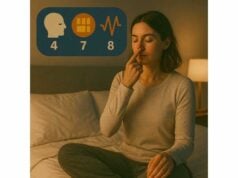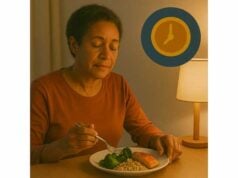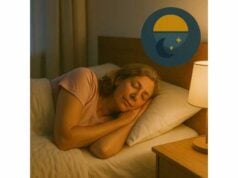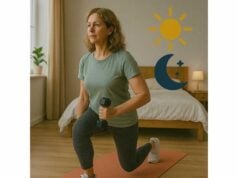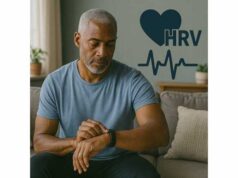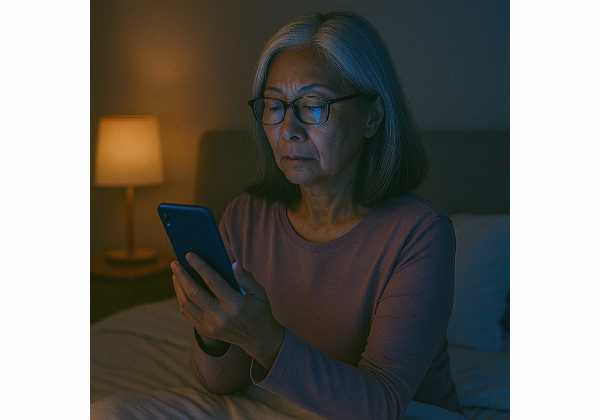
Modern life asks us to stay connected long after sunset, but biology still runs on a 24-hour clock tuned by light and darkness. After decades of research, one conclusion is clear: the kind of light you see in the evening—its brightness, color, and duration—shifts your circadian timing, suppresses melatonin, and pushes sleep later. That shift is small on any given night, yet it adds up across weeks and months, especially in midlife when sleep becomes more fragile. This guide focuses on pragmatic fixes: what to change on your screens, how to reshape evening light at home, and how to track whether your adjustments are working. If you want a broader playbook for recovery and resilience, explore our sleep and stress for longevity resources.
Table of Contents
- How Blue Light Disrupts Circadian Timing and Melatonin
- Evening Light Sources at Home and How to Manage Them
- Device Settings That Help: Night Mode, Auto Dimming, and Grayscale
- Do Blue Light Glasses and Screen Filters Actually Work
- Content Hygiene: Notifications, Scrolling, and Cognitive Arousal
- Bedroom Lighting Choices: Bulbs, Color Temperature, and Placement
- What to Track: Sleep Latency, Night Awakenings, and Next Day Energy
How Blue Light Disrupts Circadian Timing and Melatonin
Your circadian clock sits in the suprachiasmatic nucleus (SCN), a structure in the brain that reads light signals from the eyes to set “biological time.” Specialized retinal cells (intrinsically photosensitive retinal ganglion cells) are tuned to short-wavelength light in the blue-cyan range. When these cells sense evening light, they send “daytime” messages to the SCN. The cascade does three things relevant to aging and sleep:
- It suppresses melatonin—the hormone that signals biological night—on a dose-dependent curve. Brighter light, longer exposure, and higher blue content suppress more melatonin.
- It delays the circadian phase (you feel sleepy later and wake later), which can reduce deep sleep when wake times are fixed by work or family.
- It increases alertness in the short term, which feels useful for late tasks but fragments sleep when you finally try to wind down.
Brightness often matters more than color. A bright, cool-white kitchen light can push your clock more than a dim screen. Duration matters too: a few minutes of glance exposure is less disruptive than 90 minutes of immersive reading on a self-lit tablet. Timing is the third lever: light in the hour or two before bed has disproportionate impact; the same light earlier in the evening is less potent.
Age changes sensitivity. Many older adults have less light reaching the retina due to lens changes, but circadian systems can remain responsive. That means well-timed daytime light still helps with alertness and mood, while care with evening light still protects sleep. The practical takeaway is not to fear all screens but to manage intensity and timing: dim early, dimmer late, darkest during sleep.
Practical guidelines that work in real homes:
- Aim for a clear “light curve” across the day: bright outdoors (or bright indoor light) in the morning and midday; progressively dimmer light from dinner onward; very dim during the last hour before bed; dark while sleeping.
- Treat self-luminous screens as lamps. If the room is dim, your screen is effectively very bright to the eye. Reduce brightness to the lowest comfortable level and pull the device farther from the face.
- Use warmer appearance as a supplement to dimming, not a substitute. Color shifting helps, but it cannot fully replace lowering intensity and shortening duration.
Get those three levers—intensity, duration, and timing—working for you, and your biology will do the rest.
Evening Light Sources at Home and How to Manage Them
Even if you never looked at a phone, your home lighting could still be keeping you up. Many kitchens and living rooms use bright, cool-white LEDs designed for daytime tasks. After sunset they send a strong “daytime” signal to the brain. The fix is not to live in gloom; it is to curate layers of light you can control.
Start by mapping the sources you actually use between dinner and bed:
- Overhead fixtures: Often the brightest and most disruptive in the evening. Replace late-evening overhead use with lamps at or below eye level.
- Task lights: Under-cabinet strips, reading lamps, desk lights. Keep them focused and dimmable; avoid spilling light into the rest of the room.
- Screens and televisions: Treat as lamps; manage brightness and distance.
- Nightlights and hall lights: Choose true low-level options and limit their line of sight to the bed.
Then implement an “evening lighting plan”:
- Create two modes: a “bright mode” for chores early in the evening and a “wind-down mode” one to two hours before bed. Put the wind-down mode on switches you can activate with one action—smart scenes, a single dimmer bank, or a power strip of lamps.
- Use warm, low-lumen bulbs: In living areas for wind-down, choose 2200–2700 K bulbs, ideally dimmable. Pair with lampshades or reflectors that shield the bulb from direct view.
- Lower and localize: Place lights below eye level. Side-lighting is less stimulating than overhead downlights. For reading, a shaded lamp behind your shoulder puts most light on the page, not in your eyes.
- Motion-activated path lights: For bathrooms or halls, use very low level (e.g., 1–5 lumen) motion lights aimed at the floor. Avoid ceiling lights at night.
- Curtains and glass: If streetlights intrude, add blackout curtains or a light-blocking liner. Glass doors to hallways often bounce light—close interior blinds where possible.
If you want a broader set of morning and evening lighting rituals that slot into a longevity routine, see our guide to evening darkness basics.
Finally, establish a “device-down” interval that overlaps with your wind-down lighting mode. If you must use a screen late, keep the room background slightly brighter than the device to reduce the contrast hitting your eyes, then dim both together as you approach bedtime. Small adjustments here yield noticeable gains in how quickly you fall asleep and how refreshed you feel.
Device Settings That Help: Night Mode, Auto Dimming, and Grayscale
Software features can nudge behavior and reduce physiological impact, but their power depends on how you use them. The goal is simple: reduce intensity, reduce blue-weighted content, and reduce engagement.
Start with brightness and distance. Lower the backlight and keep the device farther from your face; doubling the distance dramatically reduces retinal illumination. In bed, avoid phone-to-nose viewing. A pillow-propped tablet 50–70 cm away is better than a phone at 20 cm.
Use Night Mode or similar color temperature features. These shift spectral output toward longer wavelengths. They help, but not as much as dimming. Set the warmest available temperature on a sunset-to-sunrise schedule, and still dim the screen to comfort. On TVs, select “Warm” picture modes and turn off vivid or dynamic settings.
Enable auto-dimming and ambient-light adaptation. These features reduce brightness when your environment is darker—exactly when your eyes are most sensitive. On laptops, combine auto-brightness with a manual cap in the evening.
Grayscale reduces stickiness. Switching phones to grayscale in the last 90 minutes before bed is a behavioral trick: fewer color rewards, less scrolling. Pair grayscale with a Focus or Do Not Disturb mode so notifications do not yank you back in.
Text and backgrounds: Prefer dark mode only if you keep overall brightness low; otherwise, white text on black can lead to overly bright highlights in a dark room. Increase text size so you are not squinting—effort and proximity both raise arousal.
Reader view and auto-scroll: When reading long articles at night, use reader mode to strip animations and ads. If your app supports auto-scroll at a slow pace, it reduces micro-bursts of interaction.
If you want to measure whether these tweaks actually improve sleep, you can use your wearable wisely to track latency and awakenings over a two-week experiment.
Two cautions. First, blue-light reduction is not a license to binge; long, bright sessions will still delay sleep. Second, some apps override system brightness (e.g., full-screen video or games). Set app-specific limits or use a system-wide screen-time control to taper exposure.
Do Blue Light Glasses and Screen Filters Actually Work
Blue-blocking glasses and clip-on filters are tempting because they seem like a simple fix. The evidence is mixed and often low-certainty, but a few points are clear enough to guide choices.
What they do well: Amber or orange lenses can reduce the blue-cyan wavelengths that most strongly signal “daytime” to the circadian system. Worn consistently in the last one to two hours before bed, they can lower the circadian potency of the light reaching your eyes, especially in brightly lit homes where dimming is not feasible. People with strict evening schedules—new parents on early wake-ups, shift-shift rotations, or travelers—sometimes find them useful as part of a larger routine.
What they do not do: They do not replace dimming or shorter sessions. Glasses that filter only a small slice of blue light make little physiological difference if the overall light is bright and prolonged. For “eye strain” at the computer, most trials do not show meaningful benefits compared with standard lenses. Eye strain is more about sustained focus, blink rate, dry air, glare, and poor ergonomics than about blue light per se.
Filters vs software: A physical filter over a tablet or e-reader can help if the display’s built-in night settings are limited. On phones and laptops, software is usually enough when combined with aggressive dimming.
How to evaluate a pair: Look for a spectral transmission curve, not just a marketing label. Lenses that block in the 460–500 nm band more strongly will have deeper amber color. If you choose a lighter tint for daytime use, do not expect a strong circadian effect in the evening.
If your main goal is more predictable bed and wake times, focus first on light timing and intensity, then consider glasses as a secondary tool. For a broader reset plan that pairs light timing, meals, and activity, see our guide to circadian timing.
Content Hygiene: Notifications, Scrolling, and Cognitive Arousal
Light is only half the story. The other half is what you consume on screens. News, email, and social feeds can keep your cortex revved even if your device is dim and warm-tinted. Two pathways matter here:
- Cognitive load and emotion: Competitive games, heated threads, or work messages raise arousal, which prolongs sleep latency and increases awakenings.
- Interaction bursts: Each notification is a micro-stressor. Even short, repeated check-ins act like “mental caffeine.”
Build a low-arousal evening routine:
- Declare “push-quiet hours.” Set Focus/Do Not Disturb from your chosen wind-down start until morning. Allow exceptions for true emergencies and favorite humans.
- Batch the rest. If you need to check messages, schedule one or two brief windows early in the evening, then stop. Move high-stakes topics (finances, performance reviews, health results) out of late hours.
- Switch content types. Swap fast-scrolling apps for long-form reading, gentle documentaries, ambient music, light puzzles, or audiobooks. Prefer content that ends on a clear cue (a chapter, a 10-minute track).
- Reduce friction to stopping. Use timers. Put “next episode” autoplay off. Move the most tempting apps off your home screen during the week.
- Body downshift: Pair screen changes with a physical cue—stretching, a warm shower, or three minutes of slow breathing—to signal the transition. If you want a mental buffer for rumination, see our short guide on reduce cognitive load.
If you wake in the night and reach for a device, resist the reflex. Keep a tiny notepad to jot thoughts, or use a pre-loaded, low-light audio track that plays without unlocking the screen. Each unlock is a light blast and a cognitive restart.
Finally, treat attention like a finite resource. The less friction between “I should sleep” and “I am asleep,” the more consistent your recovery will be across the week.
Bedroom Lighting Choices: Bulbs, Color Temperature, and Placement
Great bedrooms are designed for darkness with just enough light for safety. That means controlling both ambient (background) and task (specific activity) lighting, plus any stray light from windows or electronics.
Bulbs and fixtures
- Color temperature: Choose warm bulbs for bedside and dressing areas—2200–2700 K. Avoid cool-white bulbs (3000–5000 K) in fixtures you use within two hours of sleep.
- Brightness: Lower lumens are better at night. Dimmable bulbs let you keep the same fixture for different tasks. If you read, use a shaded lamp with a focused beam and keep the shade between your eyes and the bulb.
- Positioning: Favor lamps below eye level; wall sconces with shades are excellent. Keep ceiling downlights off during the last hour before bed.
Night navigation
- Path lights: Use motion-activated, low-lumen lights directed at the floor in halls and bathrooms. A gentle, narrow beam is safer than a bright overhead switch. Eye masks help if a partner reads late.
- Window management: Use blackout curtains or add a room-darkening liner. If heat is a concern, pair blackout liners with reflective shades to block both light and heat.
Electronics and indicators
- Tame LEDs: Cover or disable bright status LEDs on chargers, speakers, or smoke detectors if they shine directly toward the bed. Many “tiny” LEDs are piercing in a dark room.
- Clock faces: Choose dimmable displays or flip them away from the line of sight. If you clock-watch at 2 a.m., consider a no-glow analog clock.
Routine cues
- Establish a light choreography you follow each night: hallway path lights on; overheads off; bedside lamps at the lowest comfortable setting; bathroom light on a dim path light only. Make it muscle memory so you do not need to think when you are tired.
For a broader room checklist—temperature, sound masking, and bedding—see our practical guide to bedroom hygiene.
A dark, quiet sleep environment compounds the benefits of your screen changes. Many readers notice that once the room stays dim in the final hour, they stop needing blue-blocking glasses entirely.
What to Track: Sleep Latency, Night Awakenings, and Next Day Energy
You do not need a laboratory to tell whether your light habits are helping. Track three outcomes for two weeks while you apply the changes from earlier sections.
1) Sleep latency (how long it takes to fall asleep).
Use a simple estimate from “lights out” to the rough moment you drifted off, or let a wearable estimate it (acknowledging limitations). Your aim is consistency—most adults feel best when latency sits roughly between 10 and 25 minutes. If latency jumps after late scrolling or under bright lighting, you have a clear signal.
2) Night awakenings and time awake at night.
Count how often you fully wake and how long you stay awake. Note triggers: bathroom trips, partner’s light, device checks, pain. Add low-light path options and reduce screen access within arm’s reach at night. If awakenings drop as you dim earlier and reduce notifications, keep going.
3) Next-day energy and timing.
Each morning, rate alertness on a simple 1–5 scale and note morning light exposure. Many people find that bright, outdoor light soon after waking makes the biggest difference in afternoon energy, while reducing late light shortens sleep inertia.
Run a mini-experiment
- Week 1: Keep your current routine but log the three outcomes.
- Week 2: Implement a full wind-down protocol: warm dim lamps, Night Mode at maximum warmth, screen brightness at the lowest comfortable level, grayscale plus Focus mode, and a hard stop on interactive content 90 minutes before bed. Keep devices 50–70 cm from your face.
- Compare weeks: Look for shifts in latency, awakenings, and morning energy. If you also track bedtime regularity, check whether it stabilizes. Small but reliable changes matter more than one perfect night.
Troubleshooting
- If latency does not improve, audit brightness and duration again. Are you still using overheads late? Are you taking the phone to bed?
- If awakenings persist, address non-light factors: pain management, hydration timing, temperature, and stress strategies.
- If morning alertness does not budge, push morning light exposure earlier and longer—ideally outdoors.
Remember: your goal is not rigid perfection but a dependable rhythm. A clear, repeatable pattern of bright mornings and dim, quiet nights is the most durable “sleep supplement” you can build.
References
- Blue-light filtering spectacle lenses for visual performance, sleep, and macular health in adults (2023) (Systematic Review)
- Predicting melatonin suppression by light in humans (2022)
- Exposure to room light before bedtime suppresses melatonin onset and shortens melatonin duration in humans (2011)
- Evening use of light-emitting eReaders negatively affects sleep, circadian timing, and next-morning alertness (2015) (RCT)
- Associations between light exposure and sleep timing and sleepiness while awake in a sample of UK adults in everyday life (2023)
Disclaimer
The information in this article is educational and is not a substitute for medical advice, diagnosis, or treatment. Always consult a qualified clinician for personal guidance, especially if you have insomnia, mood disorders, eye disease, or are adjusting medications that affect sleep. If sleep problems persist for more than four weeks or significantly impair daytime function, seek professional care.
If you found this helpful, please share it on Facebook, X, or your favorite platform, and consider following us for future updates. Your support helps us keep creating clear, practical guides to healthy aging.

